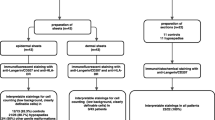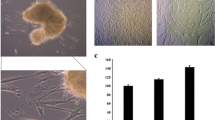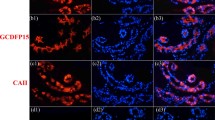Abstract
Background
Recent epidemiological studies have proposed that male circumcision reduces the relative risk of acquiring HIV-1. Here, we evaluated the density of Langerhans’ cell and degree of keratinization in the foreskins of Chinese preschool boys and adults.
Methods
Sixty preschool boys and 20 healthy men without infectious history following male circumcisions were included. The keratin thickness and Langerhans’ cells were quantified by using keratin staining, immunohistochemistry, and image analysis.
Results
The extent of keratinization was much greater in the inner foreskin than in the outer foreskin in adults and boys with infectious history. It was likely to be less keratinized in boys' foreskins compared with those of adults. The density of Langerhans’ cells was higher in the outer foreskin than in the inner foreskin of adults and healthy boys. Furthermore, an increased density of Langerhans’ cells of inner foreskin was also found in boys with infectious history compared with healthy boys. There was much higher Langerhans’ cell density in boys' foreskin compared with those of adults.
Conclusions
These findings suggest that Chinese men may have a different feature of keratin in the foreskin, and a higher Langerhans’ cells density in boys' foreskin may be due to it being less keratinized.


Similar content being viewed by others
References
UNAIDS (2007) AIDS epidemic update. http://data.unaids.org/pub/EPISlides/2007/2007_epiupdate_en.pdf
O’Farrell N, Egger M (2000) Circumcision in men and the prevention of HIV infection: a “meta-analysis” revisited. Int J STD AIDS 11:137–142. doi:10.1258/0956462001915480
Bailey RC, Plummer FA, Moses S (2001) Male circumcision and HIV prevention: current knowledge and future research directions. Lancet Infect Dis 1:223–231. doi:10.1016/S1473-3099(01)00117-7
Weiss HA (2007) Male circumcision as a preventive measure against HIV and other sexually transmitted diseases. Curr Opin Infect Dis 20:66–72. doi:10.1097/QCO.0b013e328011ab73
Short RV (2004) The HIV/AIDS pandemic: new ways of preventing infection in men. Reprod Fertil Dev 16:555–559. doi:10.1071/RD03109
Bailey RC, Moses S, Parker CB et al (2007) Male circumcision for HIV prevention in young men in Kisumu, Kenya: a randomised controlled trial. Lancet 369:643–656. doi:10.1016/S0140-6736(07)60312-2
Szabo R, Short RV (2000) How does male circumcision protect against HIV infection? BMJ 320:1592–1594. doi:10.1136/bmj.320.7249.1592
Hussain LA, Lehner T (1995) Comparative investigation of Langerhans’ cells and potential receptors for HIV in oral, genitourinary and rectal epithelia. Immunology 85:475–484
Patterson BK, Landay A, Siegel JN et al (2002) Susceptibility to human immunodeficiency virus-1 infection of human foreskin and cervical tissue grown in explant culture. Am J Pathol 161:867–873
Donoval BA, Landay AL, Moses S et al (2006) HIV-1 target cells in foreskins of African men with varying histories of sexually transmitted infections. Am J Clin Pathol 125:386–391
McCoombe SG, Short RV (2006) Potential HIV-1 target cells in the human penis. AIDS 20:1491–1495. doi:10.1097/01.aids.0000237364.11123.98
van Houten ME, Gooren LJ (2000) Differences in reproductive endocrinology between Asian men and Caucasian men—a literature review. Asian J Androl 2:13–20
Berardesca E, Maibach H (2003) Ethnic skin: overview of structure and function. J Am Acad Dermatol 48(6 Suppl):S139–S142. doi:10.1067/mjd.2003.273
Rawlings AV (2006) Ethnic skin types: are there differences in skin structure and function? Int J Cosmet Sci 28:79–93. doi:10.1111/j.1467-2494.2006.00302.x
de Vincenzi I, Mertens T (1994) Male circumcision: a role in HIV prevention? AIDS 8:153–160. doi:10.1097/00002030-199402000-00002
Corcuff P, Lotte C, Rougier A, Maibach HI (1991) Racial differences in corneocytes. Acta Derm Venereol (Stockh) 71:146–148
Roberts D, Marks R (1980) The determination of regional and age variations in the rate of desquamation: a comparison of four techniques. J Invest Dermatol 74:13–16. doi:10.1111/1523-1747.ep12514568
Taube JM, Nichols AD, Bornman LS, Bornman DM, Jackson JB (2007) Langerhans cell density and high-grade vulvar intraepithelial neoplasia in women with human immunodeficiency virus infection. J Cutan Pathol 34:565–570. doi:10.1111/j.1600-0560.2006.00663.x
de Witte L, Nabatov A, Pion M et al (2007) Langerin is a natural barrier to HIV-1 transmission by Langerhans cells. Nat Med 13:245–246. doi:10.1038/nm1541
Weiss GN, Sanders M, Westbrook KC (1993) The distribution and density of Langerhans cells in the human prepuce: site of a diminished immune response? Isr J Med Sci 29:42–43
Balat A, Karakök M, Güler E, Uçaner N, Kibar Y (2008) Local defense systems in the prepuce. Scand J Urol Nephrol 42:63–65
Flemming DT, Wasserheit JN (1999) From epidemiological synergy to public health policy and practice: the contribution of other sexually transmitted diseases to sexual transmission of HIV infection. Sex Transm Infect 75:3–17
Bentwich Z, Maartens G, Torten D, Lal AA, Lal RB (2000) Concurrent infections and HIV pathogenesis. AIDS 14:2071–2081. doi:10.1097/00002030-200009290-00002
Author information
Authors and Affiliations
Corresponding author
Rights and permissions
About this article
Cite this article
Qin, Q., Zheng, XY., Wang, YY. et al. Langerhans’ cell density and degree of keratinization in foreskins of Chinese preschool boys and adults. Int Urol Nephrol 41, 747–753 (2009). https://doi.org/10.1007/s11255-008-9521-x
Received:
Accepted:
Published:
Issue Date:
DOI: https://doi.org/10.1007/s11255-008-9521-x




